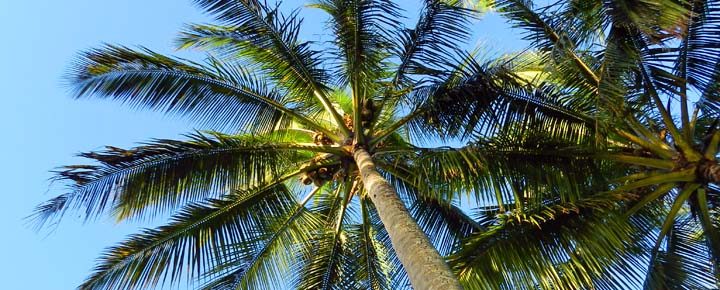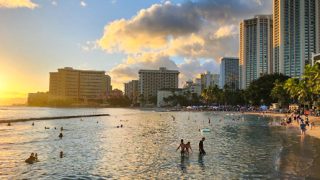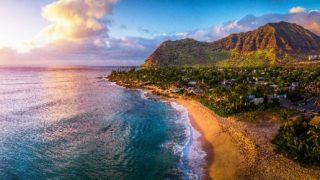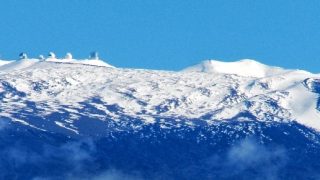Weather in Hawaii is a perennially fascinating subject for visitors and residents alike. As the rest of the US heads into what will probably be another hotter than normal season, we’re expecting temperatures mostly in the 80’s with refreshing trade winds. Ahh. If you find yourself suffering from a case of the triple digits this summer, we hope you can shut down your AC and head off to your next Hawaii vacation and favorite Mai Tai.
Sun, wind, rain, and other weather conditions are always part of the discussions here in Hawaii. In large part that is due to being small islands in the middle of a large ocean, with incumbent variability in Hawaii weather.
The Pacific Ocean is the obvious source of Hawaii’s unique weather. Ocean temperature varies by only about 6 degrees from winter to summer, between 73 and 80 degrees Fahrenheit. Located some 2,500 from the nearest continental land mass, and being one of the most remote island chains in the world, the air in Hawaii is moderated by ocean, rather than by land conditions (as is the case on continents) .
Weather in Hawaii This Summer
We’re heading into the balmy summer months now, with slightly warmer 80+ degree days and mid-60 to 70 degree nights. Even though Hawaii is closer to the equator than most of the country, the breezy flow of cool air originating from the arctic keeps us comfortable year round including summer.
Four Reasons Why Weather in Hawaii is Unique
☉ Year round idyllic temperatures with very few major storms.
☉ Moderate humidity for an island destination.
☉ Iconic cooling trade winds which blow about 80% of the time from the north and east.
☉ Microclimate variability in rainfall frequency and intensity.
Hawaii Seasons – Kau vs. Hooilo
☉ Warm “Kau” season runs from Memorial Day to Labor Day, when you will find longer and warmer days and nights.
☉ Cool “Hooilo” season is typical the rest of the year.
Hawaii Temperatures – What to Expect by Month
It is generally moderately warm and comfortable in Hawaii year-around, although from October until May (our cool season), expect nighttime temperatures in the 50’s and 60’s and days drop into the 70’s. Our lowest temperatures are found from February through April.
At the water, you’ll find only two seasons in Hawaii. But as you go up or inland, there’s more variability and you can even see trees dropping their leaves.
Hawaii Rainfall
We usually get major winter storms from November to December and from March to April. And from November through April, expect at least one month of rain. That comes out to precipitation 15 percent of the time during those six months. When these winter rains occur, they often impact the entire island chain. Intense winter rainfall can also result in runoff that makes the ocean briefly not safe for swimming.
Hawaii Trade Winds
The majority of the time, cooling trade winds are driven from the north and east as they cross the higher elevations of the state. As a result of these temperature and humidity moderating trades, the south and west sides are left warmer and dryer while most of the rain at these times is found in the mountains and valleys.
During trade wind conditions, it is usually possible to escape rain by heading to nearby drier areas. Also keep in mind that if it’s raining where you are, another part of the island may be sunny and dry.
The trade winds stop or the winds blow from the south about 20 percent of the time. South or Kona winds in winter often lead to cold and wet conditions. In summer, they lead to higher humidity.
Updated 5/22/19.






Was just checking the Hawaiian website for Mileage awards for next spring and saw no miles tickets from LAX-LIH under 61,000 miles. Most were in the 70,000 + range. Have they done away with their 35,000 mile award tickets for their credit card holders? Thanks, Andy
Hi Andy.
On checking just now, we do find 35K mile round trips available for next spring. It must just be the dates that you are looking at.
Aloha.
We visited Hawaii for the first time last August (reduced flight prices thanks to your site and tips) but unfortunately it coincided with Hurricane Lane so we missed out on those blue skies up until the day we left and some major attractions that were closed but Hawaii was still beautiful and we fell in love with it and the friendly people.
With the sun out though it was spectacular and we didnt want to go home.
We cant wait to come back and visit Oahu again as well as the other islands, for longer next time.
With the risk of global warming I hope the storms stay away for everyone as they could be truly devastating if they did make land fall.
Colin, England
Hi Colin.
Come back again soon!
Aloha.
Thank you for the explanation! Having lived on Kauai for 5 years now, I can’t say that I have understood our weather patterns as well as you have described! Weather in the Pacific Northwest seemed easier to understand, but your explanation is very straightforward. I always follow Guy Hagi and his commentaries!
Hi Raj.
Thank you.
Aloha.
Mahalo. We wish to send well wishes and prayers that. All those in the area of the volcano. Please be safe.ALOHA Karen and Ron
.
excellent commentary now I think I understand the trade winds explanation for the first time
Looking for another great fare like one I got couple years ago on United, Roundtrip from Memphis to Honolulu for $364.00. Thank you for that alert, Was great!
A little more meteorology for you…Hawaii is surrounded by a warm ocean that hardly changes; that means it is tough to get any temperature extremes (hot or cold) anywhere near sea level. Similar setup around any other piece of land surrounded by ocean. In fact the all-time high temperature for Alaska is HOTTER than Hawaii! (100 vs. 98) Land can warm up quickly in summer but the ocean rarely gets above 82 degrees around the Hawaiian Islands.